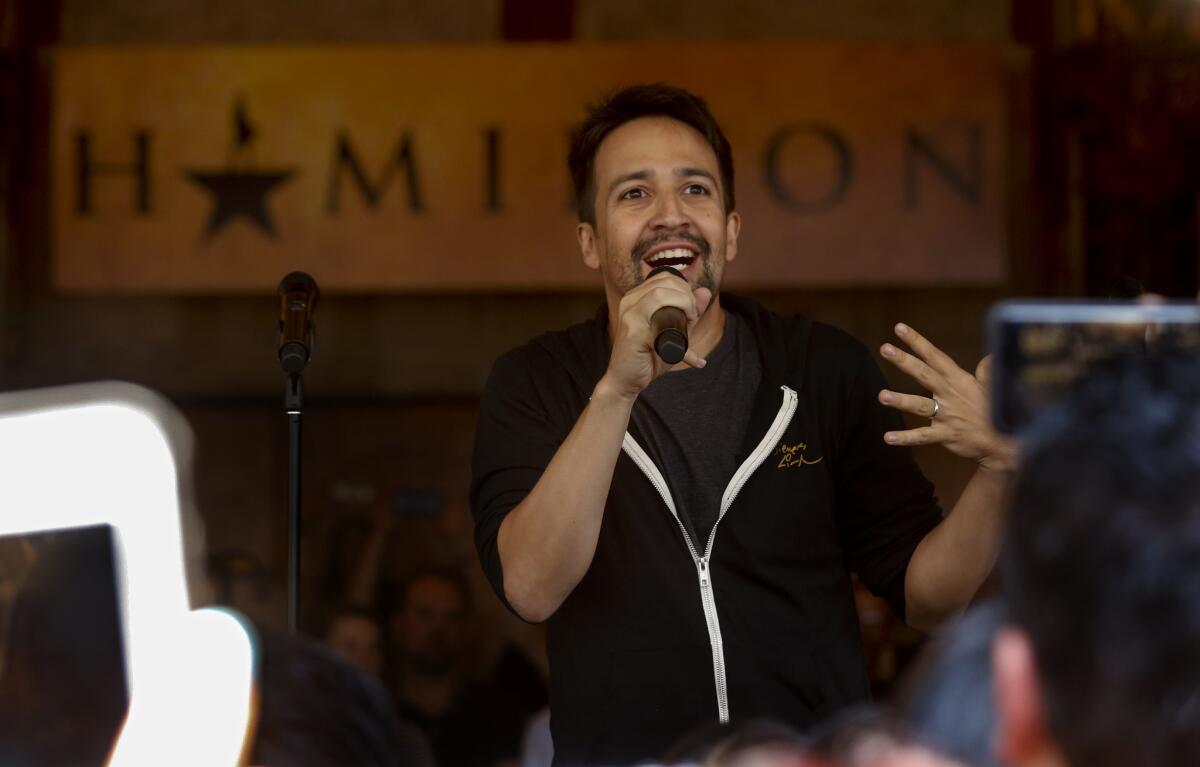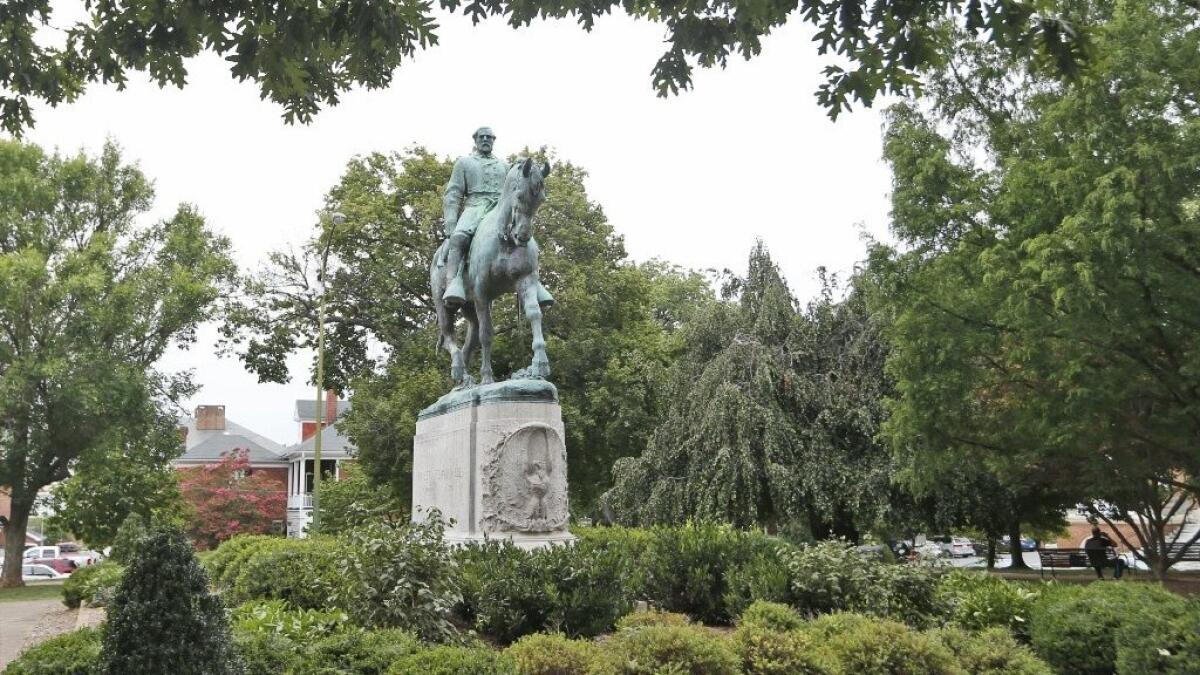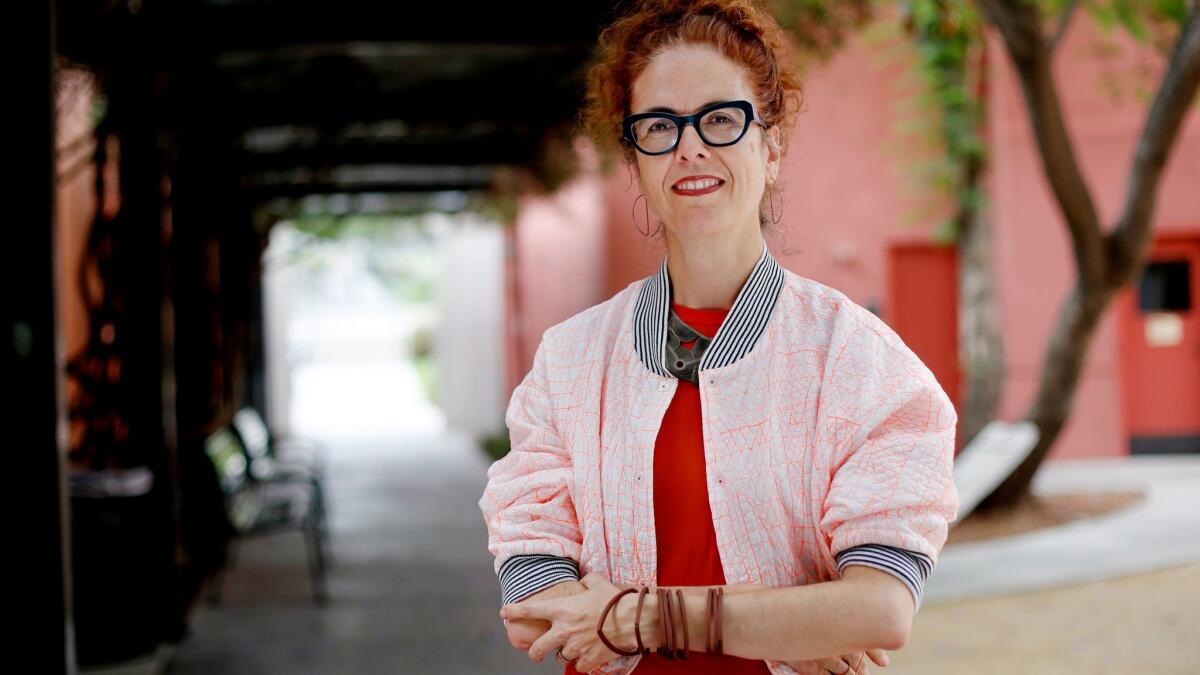Essential Arts & Culture: ‘Hamilton’ opens, the debate over Confederate monuments, Mozart reimagined

A small matter of a musical about that guy named Alex on the $10 bill. Our Confederate monument legacy. And an energizing Mozart opera in Austria. I’m Carolina A. Miranda, staff writer for the Los Angeles Times, back from a wondrous trip to Tokyo (more cube watermelons and panda donuts, please). Here is the week’s essential culture news:
My name is Alexander Hamilton
“Hamilton” has landed at the Hollywood Pantages Theatre — and it’s got L.A. more frenzied than an Oprah studio audience.
The Times’ Deborah Vankin was in the audience at the star-studdded opening night. Spotted: show creator Lin-Manuel Miranda, filmmaker Ava DuVernay and actress Halle Berry. Times staff writer Sonaiya Kelley helped to capture the scene earlier in the day when fans mobbed Hollywood Boulevard for a $10-ticket lottery and brief performance by the L.A. cast.
Times culture writer Jeffrey Fleishman examines the show’s significance at this political moment: “It has slipped quicksilver through our politics and turned a centuries-old orphan’s tale into a parable that praises American diversity at a time we are challenging the essence of who we are as a country.”
And Times theater critic Charles McNulty, who has been following the show’s evolution since it first debuted in New York, says the L.A. version would do the Founding Fathers proud. “The production,” he writes, “under the propulsive direction of Thomas Kail, seizes hold of the audience from the opening number.”
And because too much “Hamilton” is never enough, Calendar editor Mary McNamara led an hour-long conversation with Kail, as well as choreographer Andy Blankenbuehler and music supervisor Alex Lacamoire, earlier this week — and there is video!
I, in the meantime, am still trying to start the totally true urban legend that show creator Lin-Manuel Miranda and I are long-lost cousins. (C’mon, primo, gurl needs tickets.)
Find all of the Times’ “Hamilton” coverage at latimes.com/hamilton.
Monuments to the Confederacy
Communities around the nation are taking stock of monuments to the Confederacy after violence erupted at a white supremacist rally in Charlottesville, Va., over the planned removal of a monument to Confederate General Robert E. Lee. As historian Kevin Waite pointed out in an op-ed in The Times, California, too, is home to Confederate monuments — including one in Hollywood Forever Cemetery. After the story’s publication, it was removed — along with another Confederate marker in downtown San Diego.
Times art critic Christopher Knight has a powerful essay on the subject of removing these fraught civic monuments. “Some claim that removing them erases history,” he writes. “That’s backward. Erecting them does.” Of the Henry Shrady monument in Charlottesville, he adds: “Art aims for truth, while kitsch is the cheery aesthetic embodiment of a lie. The Lee monument is kitsch.” Pure fire. Los Angeles Times

Plus, Lola Arellano-Fryer has an interesting piece that looks at how many of those Confederate memorials in the South actually hail from Northern foundries. Hyperallergic
In the meantime, descendants of some Confederate figures depicted in these statues — including Stonewall Jackson, Jefferson Davis and Robert E. Lee — say they are OK with having the sculptures removed (some far more forcefully than others). New York Times
What to do with all those statues once they’ve been removed? Knight offers some ideas in his piece. Also, places such as Hungary, Taiwan and Paraguay provide interesting examples to follow — including one city that tore down a Stalin sculpture and left behind only its boots. Good work. Atlas Obscura
And because we’re all brushing up on our Civil War knowledge, some necessary reading: James M. MacPherson’s 2001 article on how the Civil War, fought over slavery, has been over time whitewashed into a conflict about states’ rights. New York Review of Books
Rethinking Mozart
Salzburg is Mozart’s birthplace, so it seems a fitting location to present his work in a fresh way. Times music critic Mark Swed took in a performance of the composer’s little-loved final opera “La Clemenza di Tito” at the Salzburg Music Festival — completely reimagined with contemporary themes by Los Angeles director Peter Sellars and Greek conductor Teodor Currentzis. The production, Swed writes, “sets new standards for how to play Mozart, how to sing Mozart, how to stage Mozart, how to think about Mozart and, through the intense effort of doing all that, how to find cliché-free hope for humanity.” Somebody please bring this to L.A. Los Angeles Times
In the galleries
Christopher Knight has been making the rounds of all the latest shows.
Of the exhibition of Dennis Hopper’s photographs at Kohn Gallery, he reports: “If you saw the blandly overblown 2010 Hopper retrospective at the Museum of Contemporary Art, which featured lots of bad paintings and sculptures draped in celebrity gauze, don’t let it deter you from visiting this far more revealing show.” Los Angeles Times
Plus, he also checked out filmmaker Alejandro Iñárritu’s virtual-reality installation about immigration at “Carne y Arena” at the Los Angeles County Museum of Art. The show, he writes, contains “banal manipulations,” but the third section, featuring the testimonies of the real migrants that inspired the project, is worthwhile. Los Angeles Times
And there is the show of “fearsome yet fragile” sculpture by Ben Jackel at L.A. Louver, some of which depicts weaponry and armor. It is, Knight writes, “a political art of a subtle and sophisticated sort.” Los Angeles Times
Plus, L.A. artist Paul McCarthy has a new show of sculptures and tapestries at Hauser & Wirth — a horror show of lurid Disney characters in moments of agony and ecstasy. “They have their feet firmly planted in reality,” writes contributing reviewer David Pagel, “in times whose weirdness is deeper and more troubling than the art’s.” Los Angeles Times
A new dean
Times architecture critic Christopher Hawthorne sat down with Ingalill Wahlroos-Ritter, the new dean of Woodbury University’s ascendant School of Architecture to talk about how diversity, development, ethics and class inform the field. “Architects in this country tend to have clients who are in the upper income level,” she says. “And I think that has really been a problem. Our students, many of them, come from underserved communities.” Los Angeles Times

In other news…
— Author Jumpha Lahiri, actor Kalpen Modi (better known as Kal Penn), painter Chuck Close and Pritzker Prize-winning Los Angeles architect Thom Mayne of Morphosis have resigned from President Trump’s Committee on the Arts and Humanities and called on him to step down in the wake of Charlottesville. The Hill
— “How many ways can a person say racism is the real bread and butter of our American mythology?” Kara Walker’s artist statement for her latest show in New York is burning up the art Internets. Sikkema Jenkins
— A controversial project by artist Jill Magid, which turned the ashes of famed Mexican architect Luis Barragán into a diamond, has landed in Mexico City. Hyperallergic
— And an exhibition in New York looks at the work of Los Angeles architect Gregory Ain, whose career was waylaid by anti-communist hysteria. New York Times
— Yayoi Kusama is opening her own museum in Tokyo. A backup plan in case you can’t get into the upcoming Kusama show at the Broad. New York Times
— In New York, a nude, all-male production of Hamlet. Mic
— A group of critics talk theater in the summer of Trump. New York Times
— Caltech is relocating seven historic Spanish Revival bungalows to make way for a new neuroscience center. Pasadena Star News
— “The absence of women from the conversation about how cities have been made, and remade, over the last 50 years has directly fed their wealth disparity and urban displacement.” Alissa Walker on how cities are mansplained. This is essential reading. Curbed
— Related, a conversation with Mabel O. Wilson about race and public place. Artforum
— Filmmaker Laura Gabbert and writer Daniel Hernandez team up for a moving short film and essay about a family divided, then brought together, at the U.S.-Mexico border. Huffington Post
— A moral history of air conditioning. The Atlantic
And last but not least…
Because no parody shall go unlinked: Donald Trump, art critic. Instagram
Sign up for our weekly Essential Arts & Culture newsletter »
More to Read
The biggest entertainment stories
Get our big stories about Hollywood, film, television, music, arts, culture and more right in your inbox as soon as they publish.
You may occasionally receive promotional content from the Los Angeles Times.











